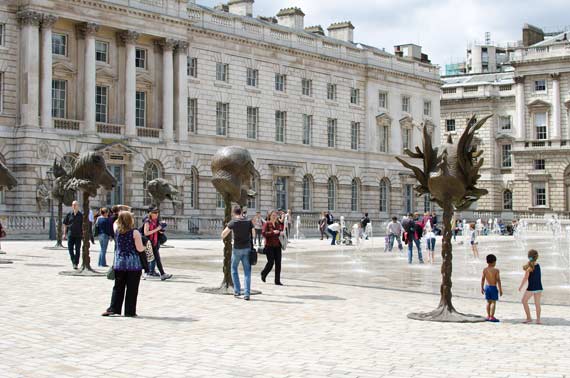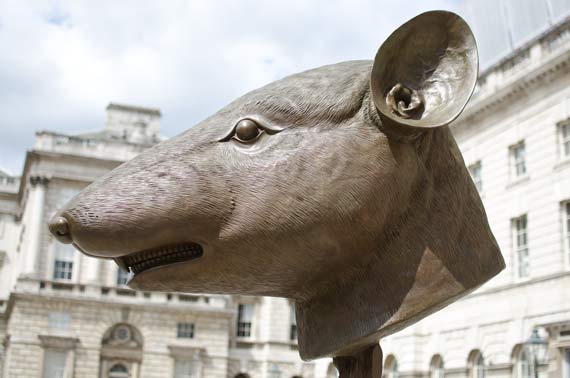
It’s a small thing, but one of the more interesting way to enter Somerset House is from Victoria Embankment by the River Thames in London. The usual entrance is off the busy road named the Strand, but there is a back staircase (at least it feels like a back staircase) from the lower level of the Embankment.
Then when you come from the quiet below into the foyer and out onto the courtyard, you are hit by the full force of the fountains, the quadrangle, and at the moment by Ai Weiwei’s huge cast sculptures of Chinese zodiac figures.
The Chinese Zodiac
The are twelve animals in the Chinese zodiac, that progress in the order: rat, ox, tiger, rabbit, dragon, snake, horse, ram, monkey, rooster, dog, and pig.
In the Chinese zodiac, the years progress through the zodiac and so do the months and even the days. So a person might be a certain animal of the zodiac for his years, and another animal for his or her months, and so on, and and every person is a mixture of these.
The traditional Chinese understanding is not so much that a person is formed or moulded by his or her zodiac but rather that a person is perceived by others as the embodiment of his or her zodiac combinations.
And unlike the Western concept of time where it is thought of as being linear, the traditional Chinese understanding of the progression of time is that it is cyclical. So when the months come around, they really do come around.
It has always interested me that two people can stand side by side and yet occupy entirely different universes – at least so far as their concept of how time is progressing.

Apparently Ai Weiwei’s sculptures are based on the zodiac symbols that were stolen from the Summer Palace in Beijing during the time of the Opium wars in the early part of the 19th century.
I read recently that Ai Weiwei made a comment about how fitting it was that the sculptures should be shown in Somerset House – a building that was just being built at the time that the Summer Palace sculptures were being stolen and spirited abroad by colonial powers.
It reminds that, as always, there is a gentle prod from the artist – about freedom and domination.
On Poles
The way the animals are on poles reminds me of the trophies of some bloody battle. And these are not cuddly representations – even the cuddly rodent has big teeth, as you can see.

On Tour
The sculptures started their tour in New York and I don’t know what the setting for the exhibition was there, but in London on a sunny day with kids running in and out of the water fountains, it felt just right and just the kind of thing that Ai Weiwei would have liked.
Ai Weiwei Detained
Ai Weiwei is being held by the Chinese authorities and has not been seen since his arrest at the beginning of April.
It is not as though he is a marginal figure, unknown outside the art world who can be ‘disappeared’ without anyone noticing or raising questions.
For example, he was the artistic consultant in the design of the ‘bird’s nest’ Beijing National stadium that perhaps you remember from the 2008 Summer Olympics.
So what does the future hold for him? There is Until recently there was an interesting article in the Chinese state-run Global Times newspaper in April. Here is an extract:
Ai Weiwei is an activist. As a maverick of Chinese society, he likes “surprising speech” and “surprising behavior.” He also likes to do something ambiguous in law. On April 1, he went to Taiwan via Hong Kong. But it was reported his departure procedures were incomplete.
Ai Weiwei likes to do something “others dare not do.” He has been close to the red line of Chinese law. Objectively speaking, Chinese society does not have much experience in dealing with such persons. However, as long as Ai Weiwei continuously marches forward, he will inevitably touch the red line one day.

This is the second article on Ai Weiwei. Click here for the article on his ‘One Hundred Million Sunflower Seeds’ exhibition.